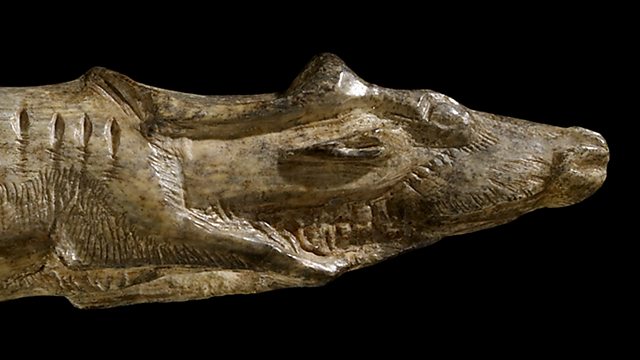Making Us Human
Neil MacGregor, the Director of the British Museum, presents an omnibus edition of the first five items in his history of humanity as told through the objects it has made.
Another chance to hear the Director of the British Museum, Neil MacGregor, retell the history of human development using 100 selected objects from the Museum - from the first stone axe to the credit card. His history will cover two million years and include items that were made in every part of the globe. In this, an omnibus of the first five objects of the series, Neil begins by recalling the first object that enthralled him a young boy of eight - and Egyptian Mummy, before examining the very the earliest examples of human ingenuity from Africa, America and Europe.
Hornedjitef was a priest who died around 2250 years ago, and he designed a coffin that, he believed, would help him navigate his way to the afterlife. Little did he know that this afterlife would be as a museum exhibit in London. This ornate coffin holds secrets to the understanding of his religion, society and Egypt's connections to the rest of the world. Neil tells the story of Hornedjitef's mummy case, with contributions from egyptologist John Taylor, Egyptian author Ahdaf Soueif and Indian economist and Nobel Prize winner Amartya Sen.
He then goes back goes back two million years to the Rift Valley in Tanzania, where a simple chipped stone marks the emergence of modern humans. One of the characteristics that mark humans out from other animals is their desire for, and dependency on, the things they fashion with their own hands. This obsession has long roots and Neil introduces one of the earliest examples of human ingenuity. Faced with the needs to cut meat from carcasses, early humans in Africa discovered how to shape stones into cutting tools. From that one innovation, a whole history human development springs. Neil tells the story of the Olduvai stone chopping tool, with contributions from Sir David Attenborough and African Nobel Prize winner Dr Wangeri Maathai
He then follows early humans as they slowly begin to move beyond their African homeland taking with them one essential item - a hand axe. In the presence of the most widely used tool humans have created, Neil sees just how vital to our evolution this sharp, ingenious implement was and how it allowed the spread of humans across the globe. And he tells the story of the hand axe with contributions from flint-napper Phil Harding, designer Sir James Dyson and archaeologist Nick Ashton
Next up is one of the earliest works of art. It is a carving of two swimming reindeer and it's not just the likeness that is striking. The creator of this carving was one of the first humans to express their world through art. Its place in the history of art and religion is considered with contributions from the Archbishop of Canterbury Dr Rowan Williams and archaelogist Professor Steven Mithen
Finally, Neil heads west to North America and an object that dates from the earliest settlements there, around 13,000 years ago. It's a deadly hunting weapon, used by the first inhabitants of the Americas. This sharp spearhead lets us understand how humans spread across the globe. By 11,000 BC humans had moved from north east Asia into the uninhabited wilderness of north America; within 2000 years they had populated the whole continent. How did these hunters live? And how does their Asian origin sit with the creation stories of modern day Native Americans? Neil MacGregor tells the story of the Clovis Point, with contributions from Michael Palin and American archaeologist Gary Haynes
And if you'd like to see the objects described in the programme, up-close and from all angles, then go online to bbc.co.uk/ahistoryoftheworld.
Producers: Anthony Denselow, Paul Kobrak and Philip Sellars
Last on
More episodes
Previous
You are at the first episode
Next
See all episodes from A History of the World in 100 Objects Omnibus
Broadcasts
- Fri 5 Mar 2010 21:00大象传媒 Radio 4
- Sun 20 Nov 2011 17:00大象传媒 Radio 4 Extra
- Fri 17 Apr 2020 21:00大象传媒 Radio 4

